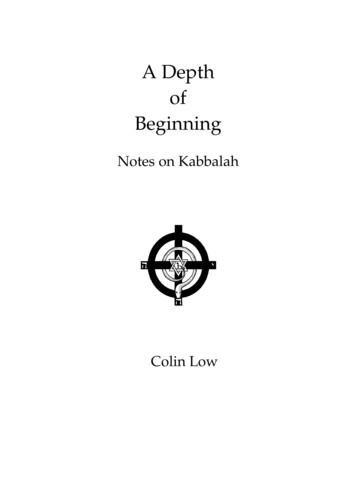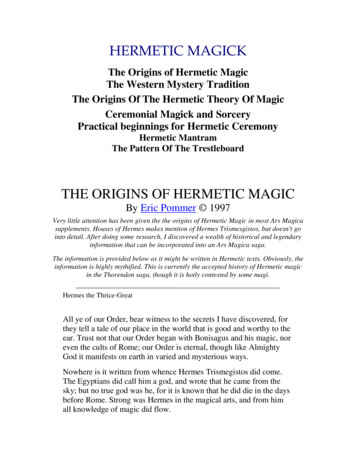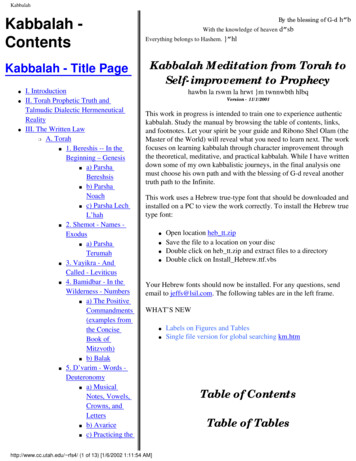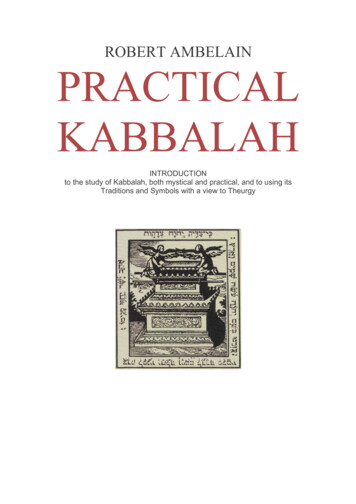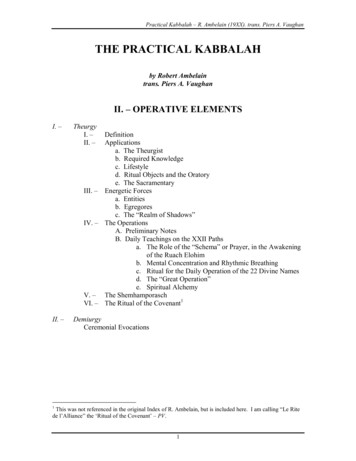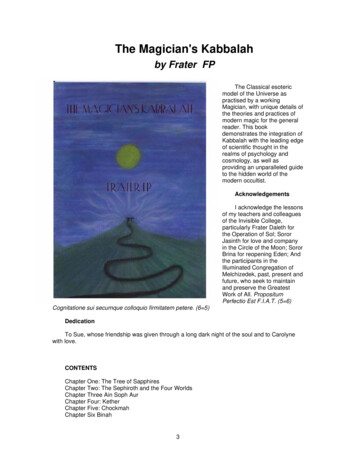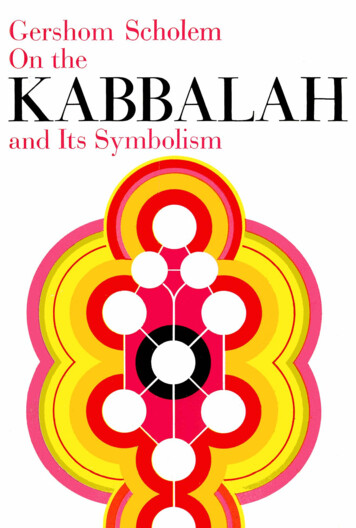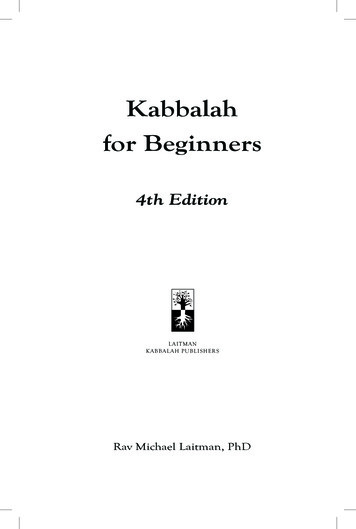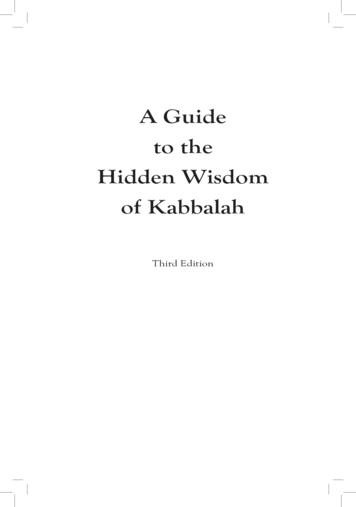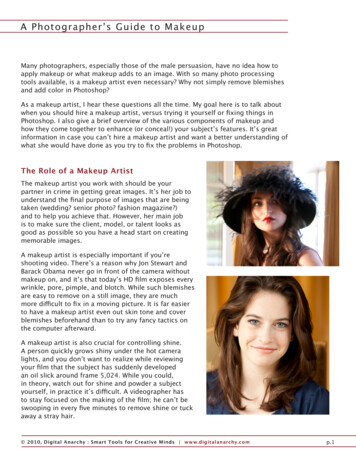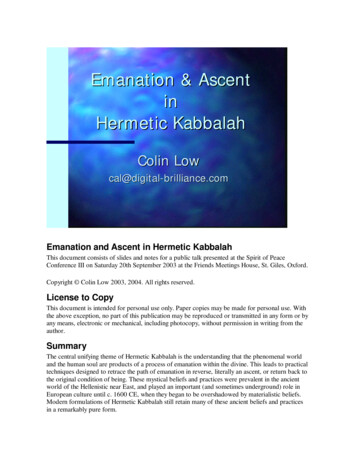
Transcription
Emanation & AscentinHermetic KabbalahColin Lowcal@digital-brilliance.comEmanation and Ascent in Hermetic KabbalahThis document consists of slides and notes for a public talk presented at the Spirit of PeaceConference III on Saturday 20th September 2003 at the Friends Meetings House, St. Giles, Oxford. Copyright Colin Low 2003, 2004. All rights reserved.License to CopyThis document is intended for personal use only. Paper copies may be made for personal use. Withthe above exception, no part of this publication may be reproduced or transmitted in any form or byany means, electronic or mechanical, including photocopy, without permission in writing from theauthor.SummaryThe central unifying theme of Hermetic Kabbalah is the understanding that the phenomenal worldand the human soul are products of a process of emanation within the divine. This leads to practicaltechniques designed to retrace the path of emanation in reverse, literally an ascent, or return back tothe original condition of being. These mystical beliefs and practices were prevalent in the ancientworld of the Hellenistic near East, and played an important (and sometimes underground) role inEuropean culture until c. 1600 CE, when they began to be overshadowed by materialistic beliefs.Modern formulations of Hermetic Kabbalah still retain many of these ancient beliefs and practicesin a remarkably pure form.
What is Kabbalah?!!!!Origin in the 12 C. CE, seeded by older texts(e.g. Sepher Yetzirah,Yetzirah, Shiur Komah,Komah, Hekhalot& Merkavah texts, Bahir)Textual interpretation is profoundly importantin Judaism (e.g. Torah scholar)Kabbalah extends the interpretation of textsin radically new directions – theosophy,cosmogony, evil, the soul, worship, practicallife, theurgy & magicDefining text: Zohar (late 13th C)Jewish mysticism - theosophical, ecstatic and practical – predates Kabbalah by more than 1000years, and generated a literature that included texts such as the Sepher Yetzirah, Shiur Komah, theHekhalot and Merkabah texts, and most importantly for Kabbalah, the Bahir. The seminal Kabbalahscholar Gershom Scholem located the origins of Kabbalah in medieval Europe in the 12th & 13 thcenturies CE. The earliest identifiable centres were in the Provence region in the south of France,and subsequently in Spain. Both were regions of high culture at that time, and were muchstimulated by contact with the Arab world, both through Moorish Spain, and also because the firstCrusades had caused large numbers of Europeans to visit Palestine.Scholem attributes the emergence of specific Kabbalistic themes to the impact of the book Bahir,along with gnostic conceptions of unknown origin, within the circle of R. Abraham ben Isaac ofNarbonne, his son-in-law R. Abraham ben David, and his grandson R. Isaac the Blind (who issometimes credited as being the ‘father of Kabbalah’).The reading and explanation of sacred texts – primarily the Tanakh (Bible) – is profoundlyimportant within Judaism. The Torah (first five books of the Bible) is not only the literal word ofGod, it is a prefiguration of all that is within the created universe. The language in which it iswritten is considered sacred, so that each letter in the Torah could be considered significant withinthe context of every other letter. The text was considered fathomless, beyond humancomprehension, but with the benefit of divine grace, the inspired Torah scholar might unlock newinsights and penetrate more deeply into God’s intentions for the Jewish people. This led to aprofusion of commentaries on sacred texts. Many were concerned with Jewish law, with thecommandments, and with ritual observance, but some went off in an esoteric and mystical direction.
The re-reading and exegesis of an older stratum of mystical texts within the context of medievalEuropean culture led to a prolific exploration in new directions – theosophy, cosmogony, the natureof evil, the human soul, reincarnation, the commandments in daily life, prophecy, theurgy, andmagic.The defining Kabbalistic text is the Zohar, a pseudoepigraphic commentary on the Bible thatpurports to originate from Palestine in the period following the destruction of the Second Temple.The dominant scholarly position is that it was written by the Spanish Kabbalist Moses of Leon morethan a thousand years later than claimed, in the late 13th century. Many orthodox Jews continue tosupport its supposed authorship.What is Hermetic Kabbalah?!!!!!Various underground theosophic,theosophic, philosophic &magical traditions surfaced during the Renaissance(e.g. Corpus Hermeticum)Continuation of prepre-Christian beliefs from theHellenistic Middle EastConfluence with Jewish KabbalahDefining text – Agrippa’s Three Books of OccultPhilosophy (1531)Kabbalah connected both to speculative Christianityand to prepre-Christian speculationThe re-discovery of Greek culture that stimulated the Italian Renaissance led to a far-reachingexploration of ideas, particularly in religion. The works of Plato, lost to the West for manycenturies, were translated into Latin. The Corpus Hermeticum, a collection of theosophicaldocuments that were believed to be the wisdom of ancient Egypt, were discovered and translated.The realisation that Judaism contained esoteric traditions and practices relating to the Bible was ofintense interest to intellectuals all over Europe, particularly as the philosophy of Plato, thetheosophy of the Corpus Hermeticum, and Jewish Kabbalah seemed to connect at many points, tothe extent that they were thought to have derived from a common source.It should come as no surprise that intellectuals, mystics and magicians should begin to take aninterest in Kabbalah. Christianity is essentially a Hellenistic gloss over esoteric aspects of Judaismdating (obviously) from the time of Jesus. It embodies much that was current both within the Greekspeaking cultures of the Middle East, and within esoteric Judaism. Even today, Bible scholars learn
Greek for the New Testament, and Hebrew for the Old Testament. After 1000 years of Christianity,medieval Europe had a natural affinity for ideas whose outlines could be discerned in Christiandoctrine.The person who did most to draw the attention of European intellectuals to the Kabbalah, with hisdaring statement “no science can better convince us of the divinity of Jesus Christ than magic andthe Kabbalah”, was Giovanni Pico della Mirandola (1463 – 1494), who made that claim as part of900 famous theses posted for public debate in Rome. He commissioned the translation of manyimportant Kabbalistic texts, and provided the stimulus for translations out of Hebrew into Latin thatcontinued through the 16th. century and into the 17th and 18th centuries.Occult sciences were widely studied before and during the Renaissance. The cosmos was thought tobe hierarchical, with God at the highest level, and various hierarchies of angelic powers, with thematerial world and the infernal regions at the outer limit of reality. It was believed thatcircumstances in the mundane world were consequences of processes happening at more subtlelevels of reality. Physical things – plants, stones, perfumes, animals, parts of the body, and hours inthe day – were believed to connect to spiritual energies by virtue of their abstract properties andassociations. There was a widespread belief (even at the highest levels in society) in the reality ofspirits who mediated various kinds of influence – benign and malign - through the creation. Thegoals of the occult sciences are familiar: knowledge, and the power to achieve ends that are todayachieved using natural sciences and technology.The most influential summation of the Renaissance occult worldview is Agrippa’s Three Books ofOccult Philosophy, a huge compendium of lore much of which can be traced back millennia. Itcontains a considerable amount of practical Kabbalah, and connects theurgic/magical techniquesconnected with Kabbalah to older pagan and Hermetic magic. Although Agrippa’s ideas wereextremely influential, they eventually fell into disrepute because they seemed to value knowledge(gained by dubious and perhaps diabolical means) over the Christian acceptance of humanity’splace in the divine scheme of things. Agrippa’s magic was displaced by the beginnings of truescience and the Age of Reason (the first draft of the Three Books was written in 1510, Newton’sPrincipia was published in 1687).The essence of Kabbalah is comprehension of the divine, both intellectually and experientially, andas such it presupposes a God. The situation in Jewish Kabbalah is clear: the God of Kabbalah is theGod of Judaism, and as such Kabbalah is an extension and elaboration of Judaism. To a large extentthe same is true of Christian Kabbalah: Christian Kabbalah is an extension and elaboration ofChristianity.The notion of divinity in Hermetic Kabbalah is very different, and derives from the philosophicnotions of the divine in Plato and Plotinus, and in the related theosophy of the Corpus Hermeticum.It is less connected with religious dogma and more with open and individual exploration. It is acontinuation of the tradition of Neoplatonist priest-philosophers such as Iamblichus and Proclus,filtered through the understanding of a generation of Renaissance mages, who integrated themysticism of the Hellenistic world with that of European Judaism.
Emanation!!!!!The sensible/phenomenal world is anendpoint of a process (emanation)Emanation bridges the distance between god& the worldDescribed in terms of discrete stages or levelsHierarchy of beingElaboration of processes & personalitieswithin & between levelsEmanation is an ancient way of explaining how a world that contains a chaotic diversity can havean underlying order and a connection with a single, unified source of all being. One of the mostimportant developments of the concept of emanation as a theory to explain the nature of existencecomes from the ancient Greek philosopher Plato and his followers, in particular Plotinus (c. 200CE).Emanation bridges the distance between the One (or the Good) and the diversity of existence bypostulating intermediate levels of being. There are many different elaborations of this idea, toomany to catalogue here. One of the most detailed and complete expositions of the Platonic view isThe Elements of Theology by the Neoplatonist philosopher Proclus (411-485), and it is interesting tofind it mirrored more than 1000 years later in the philosophy of Spinoza, an extremely influentialphilosophy which is believed to have Kabbalistic roots.As emanation begins with pure being and concludes with the real world, it usually postulates ahierarchy of being, with those beings closer to the source considered increasingly pure andundefiled by the world. These beings are considered to be real, and referred to as daemons,archons/governors, spirits, angels etc. There is much elaboration of roles, processes andrelationships between the various levels of being, as these beings are considered to communicateand regulate the influence of the divine.This is the basis for High Magic (theurgia), the belief that one can influence the processes behindthe physical world by using occult knowledge to communicate with higher levels of being. LowMagic (thaumaturgy, or goetia) is the use of spirits from lower levels of being, or in dualisticschemes, diabolical powers. The use of spirits to attain knowledge and power has been a constantsource of social friction in dualist-emanationist cultures (e.g. medieval and Renaissance Europe).
Emanationist Schemes!!!!!!!Heliopolitan Theogony (Egypt – 1000BC?)Platonism (400BC – 500CE)Jewish (Enoch literature, Hekhalot literature)Gnosticism (200CE)Hermeticism (200CE)Judeo-Christian (Celestial Hierarchies 600 CE)Medieval Kabbalah (Tree of Life, Four Worlds)Emanation was the dominant model of the cosmos throughout Europe and the Middle East from thetime of Ancient Egypt 1000 BC until the beginnings of the Age of Reason at the end of the 17th. C.It survives today in popular culture in an astonishing number of forms, from Christianity to manydifferent New Age schemes.One of the earliest forms of emanation described in any detail is the theogony of Heliopolis inancient Egypt. In this a hierarchy of divine syzygies (god-goddess pairs) are emanated from a singlesource of Being (Nun).Plato introduced the idea of emanation to the Greek-speaking world, and his ideas were developedcontinuously over the 1000-year duration of the Platonic Academy in Athens. One of the finest,most complete, and influential developments of Platonic emanation can be found in the works ofPlotinus, who lived in Roman times. These were condensed and circulated within the Arab worldduring the European dark ages (so-called) as The Theology of Aristotle and reached Europe inmedieval times, long before the original works of Plato.Early Jewish mystical and proto-magical literature envisions a cosmos that is strongly hierarchical.In the Enoch literature the sage Enoch is taken on a series of visionary journeys, in which the innerworkings of the creation are disclosed. According to this tradition Enoch was elevated to the angelsand became the archangel of the presence, Metattron. The Enoch legend provides a model of theseer who, through a combination of sanctity and knowledge, is granted privileged access to theoccult world of Being that underpins phenomenal reality.The Hekhalot and Merkabah literature provides descriptions of those things the seer will encounteron such a journey. The approach to the inner sanctum of the divine is represented by a series of
halls in the palace of a king (God) that must be traversed. The seer must be equipped with signs,sigils and magical formulae to pass the sentinels and guardians of each hall. It has been noted thatthe world of the divine is modelled on the royal court structure of the great empires that had begunto dominate the near East – Rome, Persia, and subsequently, Byzantium.Gnostic
connected with Kabbalah to older pagan and Hermetic magic. Although Agrippa’s ideas were extremely influential, they eventually fell into disrepute because they seemed to value knowledge (gained by dubious and perhaps diabolical means) over the Christian acceptance of humanity’s place in the divine scheme of things. Agrippa’s magic was displaced by the beginnings of true science and the .
